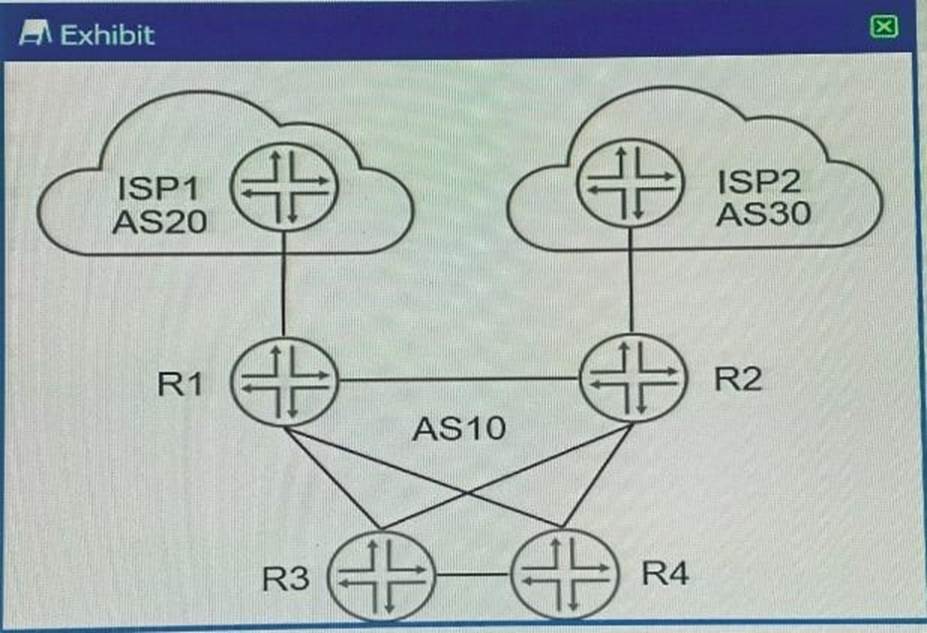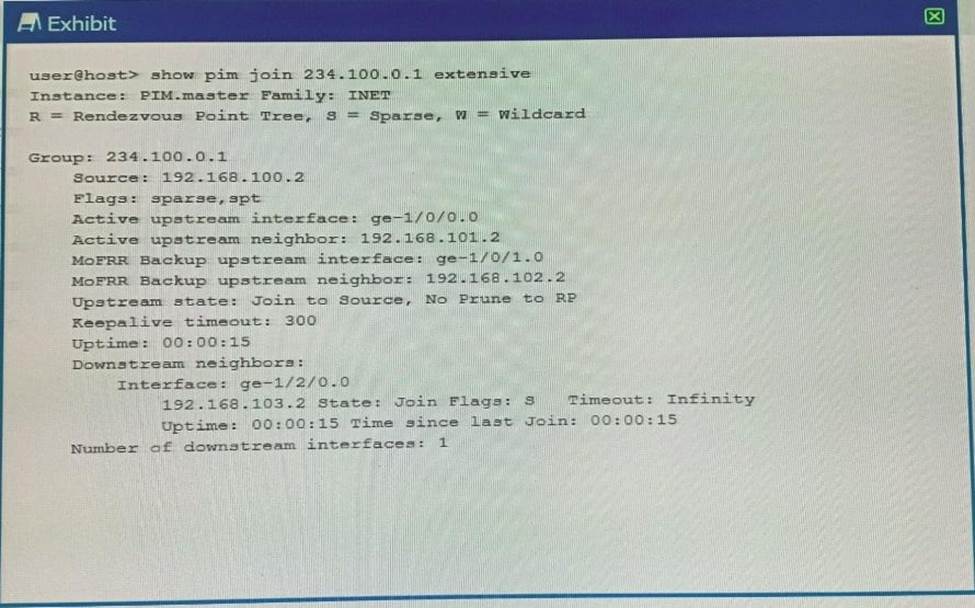Juniper JN0-663 Service Provider Routing and Switching, Professional (JNCIP-SP) Online Training
Juniper JN0-663 Online Training
The questions for JN0-663 were last updated at Dec 09,2025.
- Exam Code: JN0-663
- Exam Name: Service Provider Routing and Switching, Professional (JNCIP-SP)
- Certification Provider: Juniper
- Latest update: Dec 09,2025
Exhibit: Referring to the exhibit, you want to make ISP1 your preferred connection for inbound and outbound traffic.

Which two steps will accomplish this task? (Choose two.)
- A . Create an export policy to prepend the ASN on advertised routes and apply it to the EBGP peer on R1.
- B . Create an export policy setting local-preference 200 and next-hop self and apply it to the IBGP peers on R1.
- C . Create an export policy to prepend the ASN on advertised routes and apply it to the EBGP peer on R2.
- D . Create an export policy setting local-preference 200 and next-hop self and apply it to the IBGP peers on R2.
Click the Exhibit button.

A network administrator is investigating why traffic from R2 is not being forwarded to R1
Referring to the show isis database command output shown in the exhibit, what is causing this problem on the network?
- A . R1 and R2 are in different IS-IS areas.
- B . The preferred interface between R1 and R2 is experiencing errors
- C . R1 is configured to drop all incoming traffic.
- D . R2 is ignoring specific LSPs from R1 in its SPF calculations.
Exhibit:

Referring to the exhibit, which statement is true?
- A . The route is learned from only one neighbor.
- B . This is a multipath route.
- C . The route is learned from three different neighbors.
- D . This is a multihop route.
Exhibit:

R1 assigns incoming voice traffic to the ef forwarding class. All other traffic is assigned to the best-effort forwarding class You have configured a CoS re-write rule on R1 to include the correct CoS bit values in packets sent towards R2 You want R2 to classify traffic using the CoS markings created by R1.
Which two configuration steps are necessary to accomplish this task? (Choose two.)
- A . Configure a CoS re-write rule on R2 and assign matching CoS values.
- B . Assign the CoS re-write rule to the ge-0/0/1.0 interface on R2.
- C . Assign the behavior aggregate classifier to the ge-0/0/1.0 interface on R2.
- D . Configure a behavior aggregate classifier on R2.
Exhibit:

You notice an inconsistency between the routing table and the OSPF database, as shown in the exhibit.
What are two reasons for this behavior? (Choose two.)
- A . The LSA is a Type 4 LSA.
- B . An OSPF export policy is being applied to the route.
- C . An OSPF import policy is being applied to the route.
- D . The LSA is a Type 5 LSA.
Exhibit:

A network administrator is concerned about the number of LSAs that they are observing on the network.
What will reduce Type 7 LSAs advertised from R2 to the non-backbone routers shown in the exhibit?
- A . Configure no-summaries under protocols ospf3 on R2.
- B . Configure no-naaa-abr under protocols ospf3 on R2.
- C . Configure no-summaries under area 0.0.0.2 on R2.
- D . Configure nssa under area 0.0.0.2 on R2.
The link between CE1 and PE1 has a history of flapping To avoid the impact that flapping causes to the network you decide to use route damping
Which statement is correct in this scenario?
- A . Dampened routes decay at a sliding rate known as half-life
- B . Routes become dampened when the configured max-suppress value is reached
- C . Dampening is enabled on interfaces
- D . Dampened routes become active when their figure of merit drops below the reuse value.
Exhibit.

You are troubleshooting a problem with a BGP peer where BGP routes are not being accepted from that peer.
Referring to the exhibit, which two statements are correct*? (Choose two)
- A . Term 0 is missing a terminating action that allows BGP routes to be accepted
- B . You cannot have terminating actions outside of terms.
- C . The reject at the end of the policy is preventing the routes from being accepted.
- D . Term 0 is missing a route-fitter that specifies the allowed routes
Exhibit:

Which three statements are true about the show pim join output shown in the exhibit? (Choose three.)
- A . This is a source-specific multicast stream.
- B . The multicast stream does not have an RP.
- C . The multicast stream has been configured with a backup path to allow for fast reroute.
- D . The shortest path to the source is through the RP
E The multicast receiver is still using the RP to receive the stream.
Exhibit:

R2 is receiving a route from R1 and you must ensure that the route is not advertised to R3.
Referring to the exhibit, which two configurations on R2 will solve the issue? (Choose two.)
- A . Apply the no-export policy as an import policy under group 65001
- B . Apply the no-advertise policy as an export policy under group 65003
- C . Apply the no-export policy as an export policy under group 65003
- D . Apply the no-advertise policy as an import policy under group G5001
Latest JN0-663 Dumps Valid Version with 94 Q&As
Latest And Valid Q&A | Instant Download | Once Fail, Full Refund

